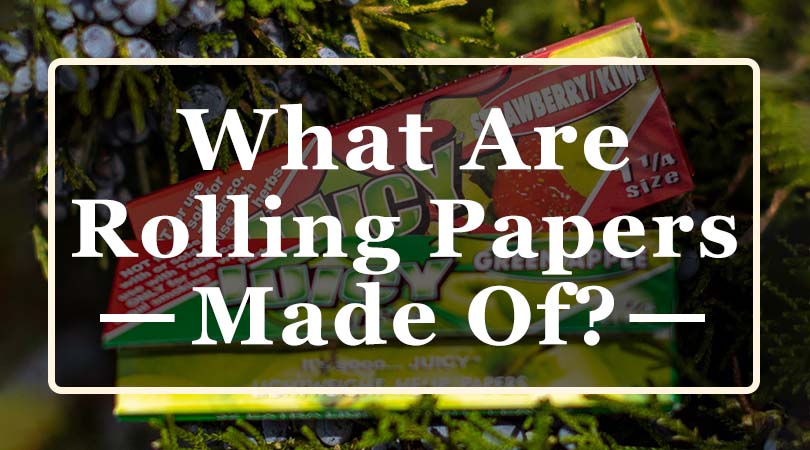
What are rolling papers made of?
Contrary to what you might think, rolling papers come in many forms, and some work a lot better than others. Luckily for you, we've already smoked with every type of rolling paper so that you can just skip to using the best one. This blog will tell you all about the types of rolling papers as well as how they're made so that you can figure out which one is best for your joint rolling adventures.
Types of Rolling Papers
There are a lot of types of rolling papers to pick from, clear rolling papers, flavored rolling papers, hemp rolling papers just to name a few. There have assuredly been an absurd number of things used as rolling papers in the past, but really there are only 5 materials still commonly and widely used today. So let’s get into exactly what rolling papers are made of.
Rice
Historically rice has been a dominant strand of rolling papers and was commonly employed throughout the 1900s. Rice is great joint paper because it is virtually tasteless, meaning you can enjoy the pure taste of your delicious bud. The drawback with rice, however, is that it is extremely delicate and therefore hard to roll/use. Rice can be an especially good choice if you are buying pre-rolls and aren't rolling your joints.
Hemp
If you want to double up on your cannabis fun, hemp is the rolling paper of choice. Hemp comes from Cannabis leaves, so yes you can smoke your cannabis in your cannabis. The great thing about a hemp blunt is they are often organic, making them a healthy option for your blunt rolling needs. Also note that like rice, hemp will not alter the taste of your bud much, and if it does in the slightest, it is a cannabis taste anyways.
Wood Pulp
If you're into the classics, a wood pulp blank could be suiting. Keep in mind however that wood pulps have fallen out of favor for several reasons. Namely, they have a distinct and powerfully unpleasant taste. Couple that with the fact that wood pulps are most likely to contain toxic substances and you can see why they have fallen in popularity. Wood pulps do have their pros though, there's a reason they have been around so long. The big one that comes to mind is that wood pulps are thick and hold their shape well, making it a good option for beginners. Wood pulps are a polarizing option these days, people either love them or hate them.
Flax
Flax is the jack of all trades master of none of the rolling papers. They're somewhat easy to roll and they don't have a superimposing taste (but it's not tasteless). They are a healthy choice however, and like hemp, the flax plant is often all-natural. Flax isn't the most popular these days, but you can still find it easily and it is not by any means a bad choice.
Esparto
Esparto rolling papers are the historically Spanish brand of blanks and were a popular choice in the earlier days of Europe. They, like wood pulps, come with an increased risk of containing toxic substances. It is even more true of esparto and there have been plenty of uproars about carcinogens being used in espartos. Espartos are also known to have a strident taste. Unless you are already used to and in love with espartos, there are better options available.
Are hemp rolling papers better
There is no easy clear-cut answer to if hemp rolling papers are better. The best rolling paper is up to the user, some people may have a strong preference for one type while others feel strongly in favor of another. If you are someone who values the healthiness of your rolling paper as a top priority, or perhaps you enjoy the idea of doubling up on cannabis, then sure hemp is the best rolling paper for you. But the answer to the question are hemp rolling papers better is no, at least not necessarily, what is better is a matter of individual preferences.
How are rolling papers made
The process of how rolling papers are made is fascinating and distinct from how writing paper is made. The exact details of the process will vary depending on the material in use as well as the company making them. There are a few steps, however, that are commonalities to all materials and companies.
Harvesting and Processing
Of course, this may seem obvious, but it must be pointed out that the first step in making rolling papers is to gather the materials. After gathering, each material will need to be processed into pulp, with some being easier to process and some being more difficult.
Forming the Pulp
Once your material is in its pulp form, it is time to mold it into the desired paper shape and size. Once the paper is shaped and sized correctly, it will be left to dry and harden so that it will maintain this form.
Cutting the Paper
At this point in the process, the original materials gathered will look like sheets of paper. Then the sheets of paper are cut into the right shape for rolling paper. Often rolling papers are shaped into booklets.
Assembling the Rolling Paper
Once the papers are cut, they are arranged either into booklets or just single sheets that can be sold in bunches. Booklets are much more common these days. There are numerous designs used to make booklets.
Toxic Ingredients to Avoid
As mentioned earlier, unfortunately, sometimes rolling papers can contain harmful substances that you should avoid whenever you can. Common toxic substances you may come across in rolling papers are titanium oxide, chlorine bleach, calcium carbonate, potassium nitrate, and artificial dyes. These substances are included for many reasons, sometimes to cut cost, sometimes to make the blunt burn longer, or sometimes just for looks. Whatever the cost, these reasons do not outweigh the harm caused by these toxins, and they should be avoided when possible. It is especially important that a toxin is not a chief ingredient in your rolling paper. Be on the lookout for these substances in your rolling paper and if you see one opt for a different option.
Harmless Rolling Paper Additives
Not all rolling paper additives are bad, some can accomplish the goals of the toxic ones without you know, the toxic part. Soy coloring can give your wraps the look you want without costing your health, they are non-toxic and often used on cakes. Another good additive is gum Arabic, which is what the adhesive at the edge of your blanks is. It comes from a tree and is all-natural. There are plenty of other additives that are non-toxic and won't compromise your health, when in doubt be sure to do some research and opt on the side of caution if you can't find anything.
Conclusion
Hopefully, you now know what rolling papers are made of as well as how rolling papers are made. Not all rolling paper materials are created equal but that doesn't mean there is one clear-cut answer above the rest. We also learned that in making rolling papers, there are lots of differences in the details, but the overarching process is much the same in all cases. Lastly, make sure to keep in mind the substances in your rolling papers and be sure to know which ones are toxic and which are safe. Rolling papers vary in material and how they're made, but as long as you stay away from toxins, you are sure to have a great time no matter which you choose.





